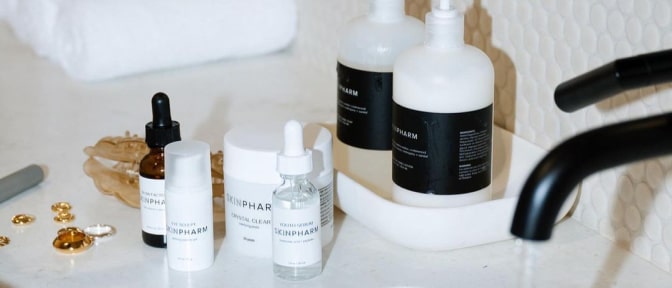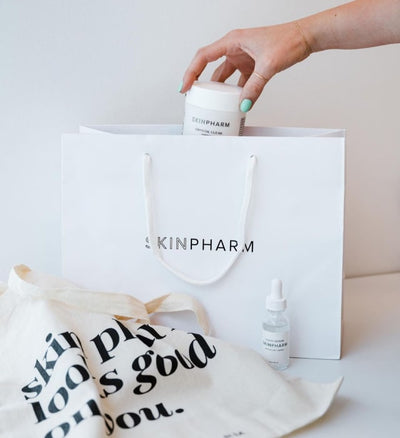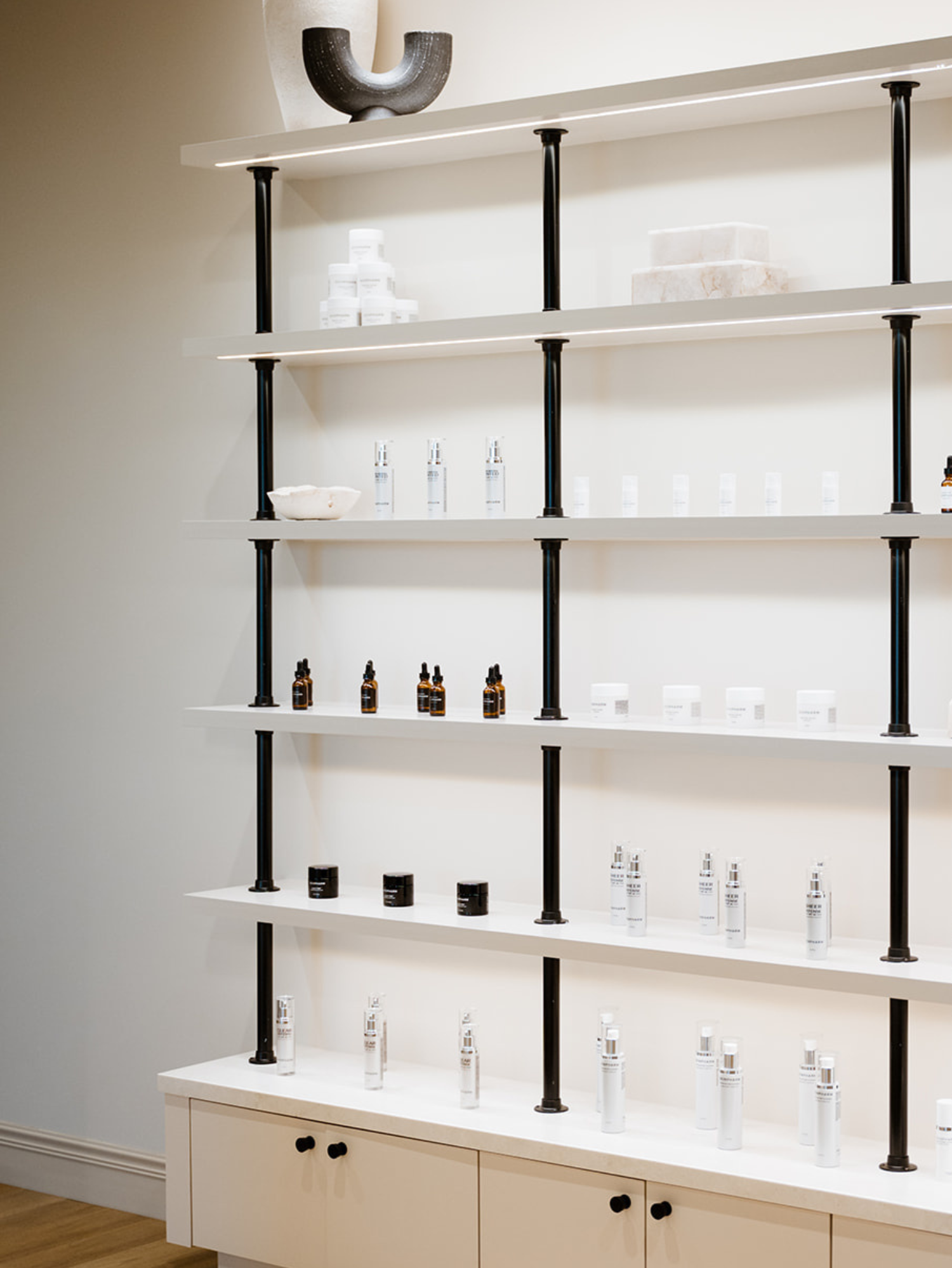Shop skin care
Clinics
VISIT OUR 9 CLINICS →
HOURS
Monday – Friday
9:30a – 5:30p
Ask Skin Pharm: Microdermabrasion vs. Microneedling

There are a lot of terms that get thrown around in the cosmetic treatment industry.
So many, in fact, that it can be really hard to keep them all straight. Two of the treatments that get the most confused, likely due to their names, are microdermabrasion and microneedling.
Although they may sound the same, these two procedures couldn’t be any more different. The crew of skin care experts at Skin Pharm are here to help set the record straight on what each is and how they may be able to benefit your skin.
That way, the next time you’re comparing microdermabrasion vs. microneedling, you’ll be able to feel confident about your decision.
Microdermabrasion
Now that we’re comparing microdermabrasion vs. microneedling, let’s start with microdermabrasion.
At a very basic level, microdermabrasion is an extreme type of exfoliation. The goal of any exfoliation treatment (whether it is done at home or at a spa or other medical practice) is to help rid the top level of the skin of the dead skin cells that accumulate there.
We all have them because they’re a part of the normal skin cell life cycle, which takes about 30 days. Once they make their way up to the very top of the epidermis, they need just a little bit of help to be “shed.”
In most cases, a normal cleansing routine is enough to get rid of them. Alpha- and beta-hydroxy acids are also helpful, which include toners and other products with salicylic acid and glycolic acid.
However, in some cases, the skin needs a little extra assistance getting rid of dead skin cells. In these instances, the build-up can cause the skin to look dull and even potentially increase the risk of breakouts.
Microdermabrasion was designed to help with that. They are considered “minimally invasive,” and the most effective types of microdermabrasion treatments are done at a spa or dermatologist’s office.
The main way that this is done is by spraying highly pressurized crystals against the skin’s surface, which are normally made from aluminum oxide. The crystals work to blast away the dead skin cells (and other debris that tends to build upon the surface), which are vacuumed away.
Microneedling
Next up, microneedling.
Microneedling is another minimally invasive cosmetic procedure, one that has been a darling of dermatologists for years. You may have seen microneedling in action before without even knowing it, as this is the process behind the infamous “vampire facial” touted by so many celebrities and influencers.
The process of microneedling that we use here at Skin Pharm starts by applying a topical numbing cream to your face to help reduce any potential discomfort. Our advanced practice providers then use incredibly small needles to puncture the surface of the skin down to anywhere between 0.1mm and 2.5mm — depending on what your goals are.
While there are plenty of at-home microneedling tools on the market, they are not recommended by dermatologists. Because the procedure includes making controlled punctures into the skin in a sterile environment, the conditions can’t be safely reproduced at home. This leads to an increased infection risk, so it’s far better to leave it to the professionals.
A unique factor of microneedling that isn’t present with microdermabrasion is the ability to include PRP treatment.
PRP, or platelet-rich plasma, is a product that is filtered out from your own blood. While that may sound strange, the research into its benefits is up-and-coming. Not just for the skin, but also for hair growth and treatment.
Using PRP can help you ramp up the benefits of microneedling even further, especially when it comes to managing age-related concerns. When applied to the skin during a microneedling procedure, the PRP is able to penetrate deep into the skin so it can provide you with the most benefits possible.
The benefits of microdermabrasion vs. microneedling
Now that we've gone over the basics of how each of the cosmetic treatments works, what are their benefits and why would you choose one over the other?
MICRODERMABRASION BENEFITS
People seek out microdermabrasion to help them deal with a few different issues. Knowing what it’s best at treating can help you decide whether or not it’s the proper treatment for your skin.
Generally speaking, microdermabrasion is best for helping to brighten up dull, tired-looking skin. It can also help unclog pores, decrease blackheads and potentially help to reduce the appearance of fine lines.
The benefits of microdermabrasion tend to show up a little faster than microneedling, but they also aren’t nearly as long-lasting.
MICRONEEDLING BENEFITS
Microneedling, on the other hand, helps with the same issues that microdermabrasion does, but a handful of other ones, too. In addition to helping reduce the appearance of fine lines, it can also decrease pore size.
With consistent treatment, microneedling may also help decrease the visibility of stretch marks and acne scarring. It can also help brighten the skin.
Another benefit of microneedling is its potential to help boost your skin’s collagen production. Thanks to various medical studies, we’ve learned that what microneedling really does is help organize the old collagen fibers while also laying down new ones, including elastin and capillaries. This leads not only to additional collagen but also to tighter, more youthful-looking skin.
It may take between one to two weeks for optimal benefits after a microneedling procedure.
Are there any side effects of either procedure?
For some people, the factor that makes the most difference to which procedure they choose is potential side effects. We don’t believe in allowing anyone to undergo any procedure without being informed of side effects or risks, so we wanted to look at them a little closer.
POTENTIAL SIDE EFFECTS OF MICRODERMABRASION
The most common side effect that people experience from microdermabrasion is redness after the procedure is finished.
Because microdermabrasion essentially is done by removing the very top layer of your skin, you should expect that your skin will be very raw for a day or two afterward. This may last longer in people who have naturally sensitive skin.
The biggest concern is post-procedure hyperpigmentation.
With any procedure involving damage to the skin, even if that damage is controlled, there is also a risk of hyperpigmentation scarring. Normally this will go away, but there may be a slight difference in your skin tone afterward.
Darker-skinned people will be more likely to notice this than lighter-skinned individuals.
POTENTIAL SIDE EFFECTS OF MICRONEEDLING
The side effects of microdermabrasion vs. microneedling are basically the same across the board. After a microneedling treatment, you may notice some redness or sensitivity for up to a few days.
There may also be some peeling three to five days after treatment as the new skin starts to push its way through the old, dead skin cells.
Microneedling is also thought to be safer for people who tend to experience post-procedure or post-inflammatory hyperpigmentation.
So when it comes to microdermabrasion or microneedling, which one is better?
We hesitate to pick which one is “better” when it comes to microdermabrasion vs. microneedling. However, in our opinion, microneedling offers more long-lasting and significant benefits when compared to microdermabrasion.
If you’re going to spend your money on cosmetic treatments, doesn’t it make more sense to get as much bang for your buck as you possibly can?
The addition of being able to add a PRP treatment to your microneedling session offers additional benefits that just aren’t attainable with microdermabrasion.
While there are tools that claim you can use them at home to achieve results, we strongly urge you to leave it to the professionals. We’re trained and licensed to follow the correct depth and target the right areas that will benefit you the most. Plus, it isn’t worth the risk of infection to do anything that punctures your skin and essentially creates a “wound” outside of a sterile environment.
If you’re still unsure, try a treatment of each and see which one your skin responds to better. There’s nothing wrong with a bit of trial and error, at least when it comes to helping find what will give you the benefits you’ve been looking for.
To sum things up...
When looking at microdermabrasion vs. microneedling and the potential benefits for your skin, take a look at your personal skin care goals.
Overall, microneedling provides a broader, more diverse collection of benefits with no additional downtime or side effects.
Skin Pharm is happy to offer this treatment in-clinic, which can help you improve both the look and the feel of your skin. Book a visit with one of our advanced practice providers in Nashville, Atlanta, Dallas, Charlotte or Franklin — we so look forward to seeing you!
SOURCES:
Platelet-rich plasma for photodamaged skin: A pilot study | PubMed
Microneedling: Where do we stand now? A systematic review of the literature | Science Direct
Microneedling: Advances and widening horizons | National Institutes of Health

















